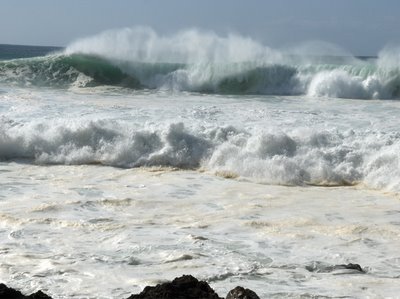 Wave Spray, North Shore, Oahu, Hawaii, February 2006, HP Photosmart R817, Exposure 1/543 sec @ f8.0, ISO 50, no flash © Steven Crisp
Wave Spray, North Shore, Oahu, Hawaii, February 2006, HP Photosmart R817, Exposure 1/543 sec @ f8.0, ISO 50, no flash © Steven CrispLet's take a wave first. Whenever you are lucky enough to go to the beach, you see them. Constantly, relentlessly, they come toward the shore. You kind of know how they are formed -- something to do with tidal action and the moon. You see the destruction they can do after a storm, or the fun you can have surfing upon them. So certainly they are real.
But let me ask you, what makes up the wave. Is it water? Well water is made up of water molecules, so is a wave just a collection of water molecules rushing to the shore? Actually no. When a wave travels by, water molecules are actually going up and down, not traveling along with the wave. The wave is based upon motion, but it is not the water that is moving toward the shore. So what exactly is moving? What is doing the damage, if it is not the water molecules?
 Double Rainbow, Oahu, Hawaii, February 2006, HP Photosmart R817, Exposure 1/163 sec @ f4.5, ISO 50, no flash © Steven Crisp
Double Rainbow, Oahu, Hawaii, February 2006, HP Photosmart R817, Exposure 1/163 sec @ f4.5, ISO 50, no flash © Steven CrispHow about a rainbow. We've all seen them after a rain storm, when the sun comes out from behind the clouds. If we are lucky, they can be bright and vivid. Stretching from horizon to horizon -- seemingly touching the ground. Sometimes there are actually double rainbows. Now anyone standing with you can see the rainbow, and describe where it is, so it must be real, right?
But a rainbow, we know, is simply water droplets in the air refracting sunlight, like a prism. And if you change your angles of examination, the rainbow will change its shape, and may disappear all together. And of course when the conditions change, the rainbow is gone. So was is real, or just some optical illusion?
 Shadow Self, Chiang Saen, Thailand, November 2005, Pentax Optio 555, Exposure 1/250 sec @ f3.8, ISO 64, no flash © Steven Crisp
Shadow Self, Chiang Saen, Thailand, November 2005, Pentax Optio 555, Exposure 1/250 sec @ f3.8, ISO 64, no flash © Steven CrispFinally consider your shadow. Sure, might as well consider your own. Everything that stands at a significant angle relative to the ground, will cast a shadow on a sunny day. Or a clear night with a full moon. Or in response to the flash of a camera. And everyone can see it. You can even photograph it. So it must be "real", right?
But you also know that if you step behind a large object blocking the sun from you, you shadow disappears. and of course when the sun goes down, bye-bye shadow. What actually makes up the shadow? It's just the absence of light hitting the ground, so indeed, "nothing" makes up the shadow. But there it is, following you around like a kid brother you just can't shake.
So what is the point of these observations? Only this: Just how "real" are you? Why are you any more real than these "things"? Everyone can see you, but they can also see waves, rainbows, and shadows. But you can "touch" yourself -- you have real form. Well, a wave has real form as well. Strong enough to carry a surfboard, or kill thousands of people.
And before you think you really are this substance called your body, I'd ask you to consider two points. First, scientists can tell you that you are 99.99% empty space (the gaps between your building block materials), and they will also tell you that those materials are nothing but pure energy. Second, do you think your identity is fundamentally tied up in that body? If you lose a limb, have you lost part of your identity? Did part of you die?
Interesting to realize the ephemeral nature of all things, even yourself.